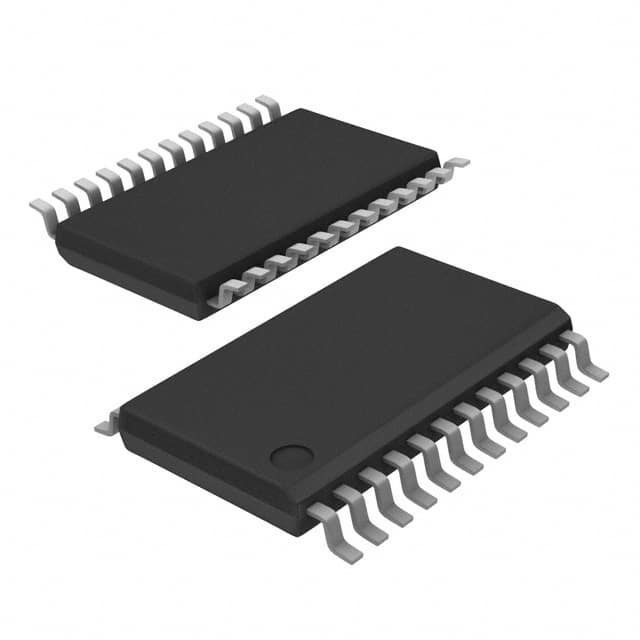Viz Specifikace pro podrobnosti o produktu.

PCAL9555APW,118
Product Overview
Category
PCAL9555APW,118 belongs to the category of integrated circuits (ICs).
Use
It is commonly used as an I/O expander for microcontrollers or other digital systems.
Characteristics
- 16-bit I/O expander with interrupt output
- Low standby current consumption
- Wide operating voltage range
- High-speed I2C-bus interface
- Schmitt-trigger action on all inputs
- Open-drain interrupt output
- ESD protection exceeds 2000 V HBM per JESD22-A114 and 1000 V CDM per JESD22-C101
Package
The PCAL9555APW,118 is available in a TSSOP package.
Essence
The essence of PCAL9555APW,118 lies in its ability to expand the number of I/O pins available for a microcontroller or digital system.
Packaging/Quantity
The PCAL9555APW,118 is typically sold in reels, with 2500 units per reel.
Specifications
- Supply Voltage: 1.65 V to 5.5 V
- Operating Temperature Range: -40°C to +85°C
- Number of I/O Pins: 16
- I2C-bus Frequency: Up to 400 kHz
- Interrupt Output: Open-drain
Detailed Pin Configuration
The PCAL9555APW,118 has a total of 20 pins. The pin configuration is as follows:
- SDA (Serial Data)
- SCL (Serial Clock)
- A0 (Address Bit 0)
- A1 (Address Bit 1)
- A2 (Address Bit 2)
- INT (Interrupt Output)
- P0 (I/O Port 0)
- P1 (I/O Port 1)
- P2 (I/O Port 2)
- P3 (I/O Port 3)
- P4 (I/O Port 4)
- P5 (I/O Port 5)
- P6 (I/O Port 6)
- P7 (I/O Port 7)
- P10 (I/O Port 10)
- P11 (I/O Port 11)
- VDD (Supply Voltage)
- GND (Ground)
- RESET (Reset Input)
- NC (No Connection)
Functional Features
- I2C-bus interface for easy communication with microcontrollers
- Interrupt output for efficient event handling
- Schmitt-trigger action on all inputs for noise immunity
- ESD protection for enhanced reliability
Advantages and Disadvantages
Advantages
- Allows expansion of I/O pins without using additional microcontroller pins
- Low standby current consumption helps conserve power
- Wide operating voltage range provides flexibility in different applications
- High-speed I2C-bus interface enables fast data transfer
Disadvantages
- Limited to 16 I/O pins, may not be suitable for applications requiring a larger number of I/Os
- Requires knowledge of I2C-bus protocol for proper integration
Working Principles
The PCAL9555APW,118 works by communicating with a microcontroller or digital system through the I2C-bus interface. It receives commands and data from the microcontroller and controls the I/O pins accordingly. The interrupt output can be used to notify the microcontroller of specific events or changes in the I/O status.
Detailed Application Field Plans
The PCAL9555APW,118 finds applications in various fields, including but not limited to: - Industrial automation - Home automation - Consumer electronics - Automotive systems - Internet of Things (IoT) devices
Detailed and Complete Alternative Models
Some alternative models that offer similar functionality to PCAL9555APW,118 are: - MCP23017 - PCA9535 - MAX7313
These models can be considered as alternatives based on specific requirements and compatibility with the target system.
In conclusion, the PCAL9555APW,118 is a versatile 16-bit I/O expander IC that offers a range of features and advantages for expanding the I/O capabilities of microcontrollers or digital systems. Its wide application field plans and availability of alternative models make it a popular choice in various industries.
Seznam 10 běžných otázek a odpovědí souvisejících s aplikací PCAL9555APW,118 v technických řešeních
Sure! Here are 10 common questions and answers related to the application of PCAL9555APW,118:
1. What is PCAL9555APW,118? - PCAL9555APW,118 is a 16-bit I/O expander with I2C-bus/SMBus interface. It provides general-purpose remote I/O expansion for most microcontroller families.
2. What is the operating voltage range of PCAL9555APW,118? - The operating voltage range of PCAL9555APW,118 is from 2.3V to 5.5V.
3. How many I/O pins does PCAL9555APW,118 have? - PCAL9555APW,118 has 16 I/O pins that can be configured as inputs or outputs.
4. Can PCAL9555APW,118 be used with Arduino? - Yes, PCAL9555APW,118 can be used with Arduino by connecting it to the I2C bus of the Arduino board.
5. How do I communicate with PCAL9555APW,118 using I2C? - To communicate with PCAL9555APW,118 using I2C, you need to send appropriate I2C commands and data to read or write to its registers.
6. Can PCAL9555APW,118 be used for driving LEDs? - Yes, PCAL9555APW,118 can be used for driving LEDs as it has open-drain outputs that can sink current.
7. What is the maximum current that PCAL9555APW,118 can sink per output pin? - PCAL9555APW,118 can sink up to 25mA per output pin.
8. Can PCAL9555APW,118 be used for reading digital inputs? - Yes, PCAL9555APW,118 can be used for reading digital inputs as it has configurable input pins.
9. Can PCAL9555APW,118 be cascaded with other I/O expanders? - Yes, PCAL9555APW,118 can be cascaded with other I/O expanders by connecting their I2C/SMBus interfaces together.
10. What are some typical applications of PCAL9555APW,118? - Some typical applications of PCAL9555APW,118 include LED displays, keypad scanning, GPIO expansion, and general-purpose I/O interfacing in various electronic systems.
Please note that the answers provided here are general and may vary depending on the specific implementation and requirements of your technical solution.

